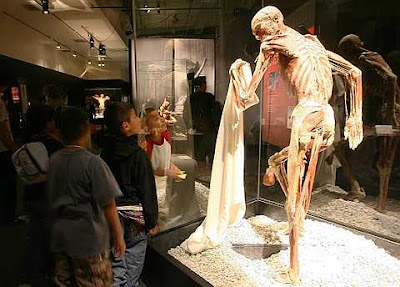
Visitors view a plastinated human body at "Body Worlds 3", the anatomical exhibition of real human bodies by Gunter von Hagens in Los Angeles on June 5, 2008. Plastination is a technique used in anatomy to preserve bodies or body parts. Water and fat are replaced by certain plastics, yielding specimens that can be touched, do not smell or decay, and even retain most microscopic properties of the original sample.

Visitors view a plastinated human body at "Body Worlds 3", the anatomical exhibition of real human bodies by Gunter von Hagens in Los Angeles on June 5, 2008. Plastination is a technique used in anatomy to preserve bodies or body parts. Water and fat are replaced by certain plastics, yielding specimens that can be touched, do not smell or decay, and even retain most microscopic properties of the original sample.

Visitors look at the plastinated bodies at the "Body Worlds 3", the anatomical exhibition of real human bodies by Gunter von Hagens in Los Angeles on June 5, 2008. Plastination is a technique used in anatomy to preserve bodies or body parts. Water and fat are replaced by certain plastics, yielding specimens that can be touched, do not smell or decay, and even retain most microscopic properties of the original sample.

A plastinated human body is displayed at "Body Worlds 3", the anatomical exhibition of real human bodies by Gunter von Hagens in Los Angeles on June 5, 2008. Plastination is a technique used in anatomy to preserve bodies or body parts. Water and fat are replaced by certain plastics, yielding specimens that can be touched, do not smell or decay, and even retain most microscopic properties of the original sample.

Plastinated human bodies are displayed at "Body Worlds 3", the anatomical exhibition of real human bodies by Gunter von Hagens in Los Angeles on June 5, 2008. Plastination is a technique used in anatomy to preserve bodies or body parts. Water and fat are replaced by certain plastics, yielding specimens that can be touched, do not smell or decay, and even retain most microscopic properties of the original sample.

No comments:
Post a Comment